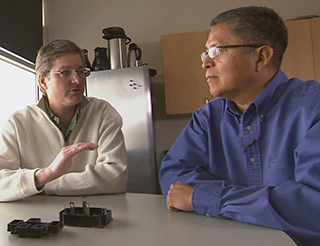Carbon dioxide separation technology also wins a ‘green technology’ gold award

Sandia R&D 100 winner Stan Atcitty, right, discusses power conversion with John Hostetler of United Silicon Carbide Inc.
Competing in an international pool of universities, corporations, and government labs, Sandia researchers captured five R&D 100 Awards this year. One entry also won the R&D 100’s “Green Technology Special Recognition Gold Award.”
R&D Magazine presents the awards each year to researchers whom its editors and independent judging panels determine have developed the year’s 100 most outstanding advances in applied technologies.
The awards, with their focus on practical impact rather than pure research, reward entrants on their products’ design, development, testing, and production, and were dubbed “the Oscars of invention” by former Chicago Tribune science writer Jon Van.
Sandia’s winning entries:
CO2 Memzyme is an ultra-thin membrane that is the first cost-effective technology for carbon dioxide separation and capture to meet and exceed DOE targets for helping to reduce the threat of climate change. This invention also won the R&D 100 contest’s Green Technology Special Recognition Gold Award. Principal investigators (PIs): Susan Rempe (8635), Jeff Brinker (1000), and University of New Mexico research associate professor Ying-Bing Jiang. Sandia’s Laboratory Directed Research and Development (LDRD) office provided early development money for this project; funding also provided by DOE Basic Energy Sciences and the Air Force Office of Scientific Research.
LED Pulser uses light-emitting diodes instead of expensive lasers to provide high-brightness, rapidly pulsed, multicolor light for scientific, industrial, or commercial uses. The Pulser’s small LED source permits better ignition detection via high-speed imaging and already has resulted in better understanding of injection, combustion, and emissions formation in diesel engines. The work was supported by DOE’s vehicle technology office. PI: Chris Carlen (8362)
ICID, or Integrated Circuit Identification authenticates integrated circuits, detects counterfeit electronics, and verifies individuals’ identities and their transactions using a unique device signature and cryptographically secure challenge-response protocol. PIs: Jason Hamlet (5627), Todd Bauer (1746), Lyndon Pierson (emeritus). Technology development was funded by Sandia LDRD.
Lightweight Distributed Metric Service (LDMS) monitoring software provides detailed awareness of the system-wide performance of high performance computers and applications in production environments. PIs: Jim Brandt, Ann Gentile, and Benjamin Allan (all 9328) and Tom Tucker, Narate Taerat, and Nichamon Naksinehaboon (all from Open Grid Computing Inc. in Austin, Texas). The work was funded by DOE. Early funding was provided by LDRD.
6.5kV Enhancement-Mode Silicon Carbide JFET Switch: A low-loss power switch based on a novel silicon carbide junction field-effect transistor will improve the efficiency of next-generation power conversion systems used in energy storage, renewable energy, and military applications, as well as data center power distributions. Sandia PI: Stan Atcitty (6111) in collaboration with United Silicon Carbide Inc. and DOE.
The awards were announced in Las Vegas Nov. 13.